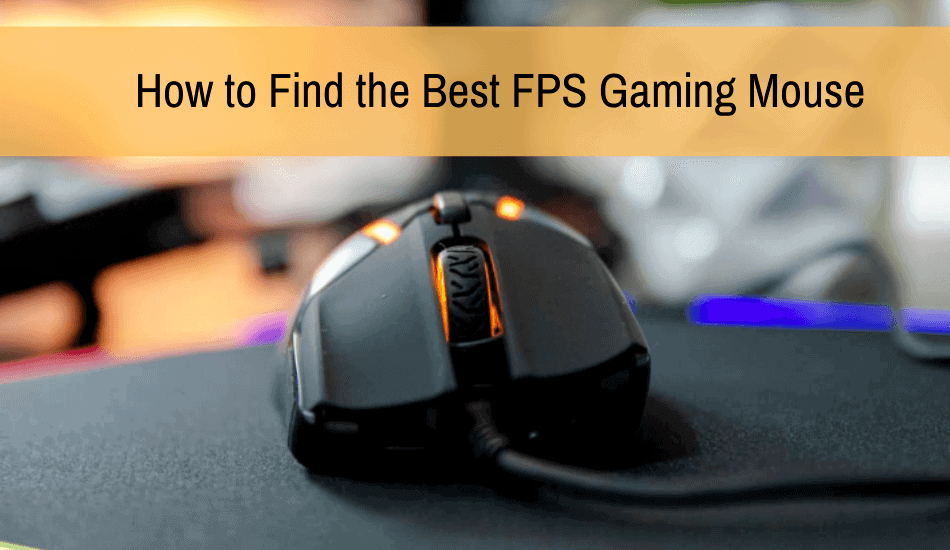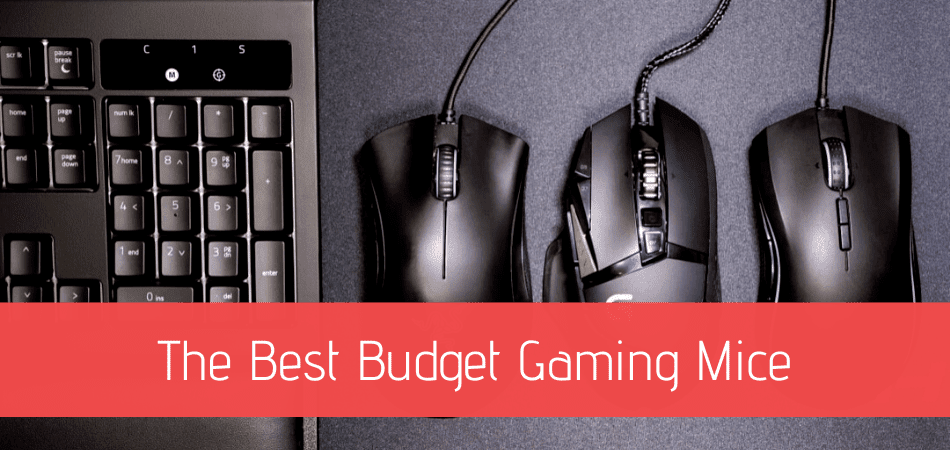As the games industry grows by the year, as does the amount of first-person shooter titles (or FPS titles, as they’re often referred to). From Call of Duty to Overwatch, basically everyone has at least messed around with a game of this nature at some point. Most likely on a typical games console such as a Playstation or an Xbox.
When played on PC however, is where players really get serious. With Esports really coming into their own in recent years and becoming quite a booming business, everyone wants a piece of the action, and what’s the first thing you go to in order to improve your in-game performance? Your mouse.
In these games, speed and precision are everything. You need to be able to react fast and react precisely. For this, your mouse needs to have accurate sensors and be of the lighter variety. Of course, nothing is set in stone, everyone has their own preferences. When speaking of the best way to play FPS games though, a light mouse is generally regarded as the way to go.
Some popular titles that benefit nicely from a mouse upgrade are; Overwatch, Fortnite, Call of Duty, Counter-Strike, etc.
What to look for in an FPS mouse

Weight
When shopping around for a mouse to use in FPS games, a good first priority to have is the weight. You want your mouse to be light. It differs from person to person, but in general, the lighter it is, the better. The best mice in the category currently on the market average around 80-90g, which is… Well, it’s pretty light.
Some mice prioritize the weight more than others. For instance, Finalmouse is a company known for making extremely light mice. The lightest, high-performing mice, at that. It’s an impressive feat, and if weight is your top priority, they’re a great place to start looking.
The “Finalmouse Ultralight Pro” weighs a meager 71g and yet performs astonishingly well in basically all areas.
It’s gained the favor of the Fortnite community for sure, as the ever-popular Twitch streamer Ninja, happens to use it as his mouse of choice in-game.
Sensor
A good sensor is a difference between a 15 dollar mouse and a 115 dollar mouse. It’s what relays the movement information to the PC, and the better the sensor is, the faster and more accurately it can do that. Now, mouse sensors come in two types. When talking about gaming mice, it tends to be a very heavily discussed area.
First up, you’ve got laser sensors. Generally considered to be the lesser of the two nowadays, laser sensors are just as they sound. They’re lasers. They’re handy as they can be used on basically any surface, and when introduced, they commanded the market as being the way of the future due to boasting higher accuracy. Although, in time, technology in optical mice has caught up, and in many cases now, passed out laser mice.
When buying cheaply, this is usually what you’ll come across, though some high-end companies are still very keen on them. Razer, for example, is immensely fond of lasers to this day and being a gaming-oriented company, it makes sense in a lot of ways.
A laser sensor is more accurate and will have a higher DPI, meaning it tracks more dots per inch. This used to mean a lot more than it does today, but note that a higher DPI is typically considered better. This isn’t entirely true today, as technology has advanced, but some eagle-eyed consumers may still notice the difference.
For gaming though, some hypersensitive people may pick up on it, and if perhaps you tested things out in a store or at a friend’s place and felt it, by all means, go down the route of a laser mouse. There are some great ones out there.
The second type of sensor you’ll come across is a lot more common in gaming mice today, and that is the optical sensor.
Optical sensors, unlike lasers, use an LED light shining onto the surface below it in order to detect movement. These mice are said to be better suited to use on mouse-mats, but honestly, with how mice are today, you don’t necessarily need one.
I own an optical mouse and it works just as well off the mat as it does on my desk. Note that some mice will have trouble functioning on glossy or reflective surfaces though. Optical sensors generally cap out around 3000 DPI, whereas laser sensors are commonly 6000. Don’t base your decision on this though, as 3000 on a decently built mouse is more than enough for nearly everyone.
Optical sensors are used on most modern gaming mice, so odds are if you’re shopping around and happen to like a mouse, it’s going to be optical.
Shaping

The shape of the mouse is perhaps the most important feature that is often not even considered. To be fair, if you’re sticking with the top brands such as Razer, Steelseries, Logitech, etc. you likely won’t run into much trouble with shape, but even then it’s important to consider the size of your hand and how you hold your mouse.
It’s simple enough; take a look at how it is your hand is resting on your mouse right now as you move it around as naturally as possible.
Generally, you’ll fall under one of these three categories:
- Fingertip grip: Your fingers are laid out on the mouse nearly flat. You use the tips of your fingers to operate the mouse. This grip style is known for having the highest level of control.
- Claw grip: Your hand grips the mouse like a claw. Arches raised, poised for battle. This grip style is supposedly good for gaming but gets uncomfortable in time.
- Palm grip: This is the most common grip style. Your fingers and palm are laid flat on the mouse. It’s comfortable and preferred by most people. It is, however, less accurate when it comes to clicking. It is less popular in gaming because of this.
Figure out which way you grip yours? Cool. This is handy information to have, as a quick search around the internet for reviews on the mouse you’re looking for will herald results such as “suitable for fingertip/claw/palm grip users”.
Knowing how you hold yours will give you better insight into how the mouse is built to be used as if the mouse is being recommended for use with the claw grip, and you hold your current mouse using the palm grip, it’s possible that mouse may not be the most comfortable of experiences for you.
Hand size
Hand size is another important factor to consider, as of course, not all mice are made the same. Most are built as a sort of “one size fits all” thing, but some are most definitely made with bigger or smaller hand sizes in mind.
Not sure what size category your hand falls into? Don’t worry, it’s easy enough to check it yourself. Simply measure from the top of your middle finger to the base of your palm. Now measure horizontally, holding your hand flat, your thumb included. Not too difficult.
From here, you’ll notice that some companies and review sites list the appropriate hand size for the mouse in question, be it suitable for small, medium, large. You get me.
Buttons, buttons, buttons!

The average, every-day mice are equipped with your basic left and right click and scroll wheel. Sometimes the scroll wheel is clickable, but that’s about the extent of it. Gaming mice are quite different in this regard, as due to the complexity and need to reach buttons quickly in some games, particularly competitive ones, they feature a wide array of buttons.
Ranging from somewhat basic additions such as a button or two of the side where your thumb rests, all the way up to the madness that is mice with 20+ programmable buttons. It gets bonkers, and this is no different from FPS games.
With an FPS though, you certainly don’t need 20 buttons. You probably don’t even need 10. A well-equipped gaming mouse for an FPS comes with around 7 buttons. Usually, the set-up is as follows; Left and right-click, scroll-wheel click, a button positioned above the scroll wheel, and three shaped around your thumb on the side.
You can even purchase mice with what is called a “sniper button” on the side, which is essentially just a big button with a crosshair on it. It’s neat stuff though. An example, if you’re curious would be the “Corsair M65 Pro FPS Gaming Mouse”.
Some recommendations
Now, assuming you’ve read everything above and haven’t just skipped down to the recommendations, yes, you, I’m looking at you, you should be more than ready to go out and choose your own FPS mouse.
The real fun part begins now! Actually shopping. I’ll run through some good recommendations here, but don’t worry too much about straying from my list, as there are simply too many fantastic mice perfectly suited to this very subject to list.
I’m simply going to list some I think are excellent, and almost anyone would be more than happy with it. First up, one of the best mice around in any genre, and my personal weapon of choice…
Steelseries Rival 600

This a good mouse. Like, a really good mouse. In fact, it was voted the “best mouse of 2018” by both IGN and Techradar, if that tells you anything. It features seven buttons. The common set-up of three on the side and one on the top, plus the usual three that accompany every mouse.
The tracking is phenomenal on this mouse, the accuracy at which it moves across the screen is mind-blowing. I still get a kick out of how nice it is.
It comes with detachable sides, hiding little compartments in which you can place the included weights. So whether you want the mouse to weigh very little, or quite a bit more, or somewhere in between. It’s completely customizable, and entirely up to you.
For instance, I play a fair bit of Overwatch in my spare time, and being able to remove the weights when I play that, and put them back in when I’m doing something slower like simple web-browsing, is just brilliant. This mouse comes with a big ol’ recommendation from me, I mean heck, it’s even got full RGB lighting. Give it a go.
Logitech G PRO Wireless

Considered to be the best gaming mouse on the market by many people, Logitech’s G Pro Wireless is a tough one to beat.
Weighing only 80g and boasting a lightning-quick 1ms response rate, this mouse is built for and marketed toward esports pros. The problem, of course, is one that all wireless mice currently face; the price.
This thing comes in at the hefty sum of $149.99, which is more than enough to scare away most people. But, to be fair here, this is a God-tier mouse, and they’re aiming for the pro player market. For someone who makes living playing games, 150 dollars isn’t a bad investment for what this mouse offers. For the rest of us? It’s hard to say.
If you travel with your gaming rig a lot, or simply want to go for that clean wireless look for your set-up, and have the cash to back you up, then hey, this might be the best option out there. It features 4 extra buttons; two on each side of the device, so you’ll have plenty of space to map out your FPS shortcuts.
Zowie FK series 2
Here we’ve got a deceivingly simple and basic looking mouse. But in actuality, this is an incredibly high performing mouse, with praise all across the board. There’s nothing particularly special about it, true, but everything it does, it does extremely well.
The sensor is solid, the design is well thought out, and shaped nicely for comfort. It weighs only 85g and features a nice seven buttons; two programmable buttons on either side, plus the basic three. Unfortunately, you can only use the buttons on one side of the device at a time, so either left or right, which is a little odd, but I suppose you may be pressing them accidentally.
You can adjust the DPI, as with most gaming mice, though unlike others, there is no software to go along with this one. You will have to adjust using the on-board buttons exclusively. It is on the smaller side though, so be aware of that. A lot of gaming mice these days are rather large, just note that this one doesn’t quite fall into that. For 69 dollars though, you’re getting a super good mouse for the money here.
Finalmouse Ultralight Pro

Oh, Finalmouse. You sure do how to make an FPS mouse. The Finalmouse Ultralight Pro is more or less what it sounds like. A pro gaming mouse designed to be as light as possible. This is mostly achieved through the removal of a lot of the mouse’s shell by way of a honeycomb-like pattern of holes reaching across the device.
Thankfully, this avoids the left and right buttons, but I wouldn’t recommend eating whilst playing with this one. Bewilderingly, it only weighs around 70g and features 6 buttons; two on the side, and one above the mouse wheel. Plus the usual three. It’s got a brilliant optical sensor and is recommended worldwide by FPS pros.
One thing to note with this one is that it seems to forever be in very high demand. Whether or not this is just a marketing ploy is beyond me, but their website makes sure you’re aware that wait times may be slower than usual. This warning has been there for a few months now at the time of writing, so it’s hard to say if it’ll ever go away.
But, if weight is your primary concern, you won’t find a mouse as light as this that can perform anywhere near as well as this one does.
Razer Deathadder Elite

Razer’s ever-popular Deathadder still rakes in the awards with its fantastic design and performance. I used to own a regular Deathadder and used it as my daily mouse for years. These are fantastic mice, and I totally get the praise for them.
The newer Elite version offers nearly the same design, with added grip on the right-hand side and two buttons above the scroll wheel.
Razer’s given it what they’re calling the “World’s most advanced optical sensor” and while I can’t exactly speak to that, I can say that the older models were fantastic, so this must be an absolute joy to use. It weighs 105g and features Razer’s signature Chroma RGB lighting. The logo and scroll wheel light up. It’s neat.
This isn’t exactly the most advanced or lightest mouse out there, but what it does have is a design and shape that has been fine-tuned for years and is now one of the most comfortable recommendations you can make to anyone looking to get more seriously into gaming.
Good luck!
And with that, you should be more than prepared to step into the world and start shopping your heart out in search of the ideal FPS mouse.
I’d recommend if you’re in an area where it’s possible, that you get to a local store and try out every gaming mouse they’ve got to offer. Everyone likes things a little differently, so if my recommendations feel off to you, don’t worry. Just take your time, do your research, it’s an expensive enough device and not something you want to rush into buying.
But what do you think? Have I made an absolute blunder in my recommendations? Have you got any further insight into what goes into making a great FPS mouse? Do let us know!




